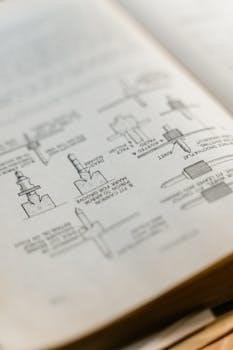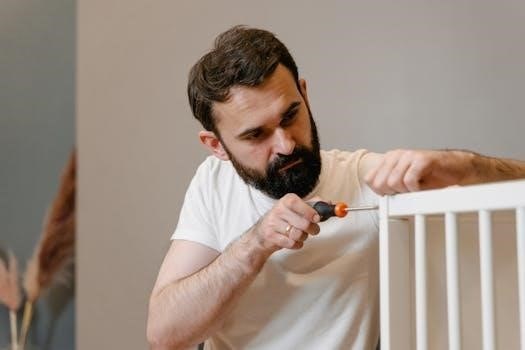4-in-1 cribs are designed to adapt to your child’s growth, transitioning from a secure crib to a toddler bed, a daybed, and finally, a full-size bed. This offers long-term value, and multiple configurations.
Overview of 4-in-1 Crib Functionality
The primary function of a 4-in-1 crib is its versatility, offering four distinct configurations in a single piece of furniture. Initially, it serves as a standard crib with a secure enclosure for infants. As the child grows, the crib can be converted into a toddler bed, usually by removing one side and adding a guard rail. Further progression allows for the crib to transform into a daybed, providing a comfortable place for daytime rest. Finally, it can be configured into a full-size bed, extending its use into the child’s teenage years. This adaptability makes it a cost-effective solution for long-term use, and it maximizes space.

Assembly Preparation
Before starting the assembly, it’s crucial to prepare thoroughly. This includes verifying all parts are present, carefully reading the manual, and gathering the necessary tools for assembly.
Checking Parts and Hardware
Prior to commencing the assembly of your 4-in-1 crib, a meticulous check of all components is paramount. Begin by comparing the received parts against the parts list provided in your instruction manual. Ensure you have all the necessary wooden pieces, such as the headboard, footboard, side rails, and mattress support. Next, verify the presence of all required hardware. This includes bolts, screws, washers, and any specialized fasteners. Pay close attention to the quantity and size of each item, as listed in the manual, to avoid any delays or frustrations during the assembly process. It is essential to lay out all parts on a clean, protected surface to easily identify them and prevent loss or damage.
Reading Instructions Before Assembly
Before you begin assembling your 4-in-1 crib, thoroughly reading the entire instruction manual is crucial. This step ensures a safe and correct assembly process. Pay close attention to all warnings and safety guidelines provided by the manufacturer. Familiarize yourself with the sequence of steps, paying specific attention to diagrams and illustrations; Understanding the proper order of assembly will prevent potential errors and the need to disassemble and redo parts of the crib. Carefully read any notes or special instructions regarding specific parts or assembly steps. This will ensure that all parts are correctly aligned and attached, promoting the stability and safety of the crib.
Tools Required for Assembly
Having the correct tools readily available before starting the assembly of your 4-in-1 crib is essential for a smooth process. Typically, you will need an Allen wrench, often included with the crib hardware, for tightening bolts. A Phillips head screwdriver is usually required for various steps, and sometimes a flathead screwdriver may be necessary. It’s advisable to have these tools on hand before you start. Check your instruction manual to verify that you have all required tools. Using the correct tools will prevent damage to the crib’s components and ensure a secure and stable assembly, and will make the process more efficient.

Crib Assembly
Assembling your 4-in-1 crib requires careful attention to the provided instructions. This stage involves connecting the crib’s main components using bolts and other hardware for a stable structure.
Step-by-Step Crib Assembly Guide
Begin by identifying all parts and hardware against the parts list. Start by attaching the back rail to the crib ends using the specified bolts, ensuring they are only finger-tight at this stage. Next, secure the front panel, if applicable, following the same method. After the main frame is together, insert the mattress support, adjusting its height as needed. Proceed with bolting the frame together, using an Allen wrench. Do not fully tighten any bolt until all parts are connected, and always work with a partner to ensure safe and accurate assembly. Double check for stability and correct alignment.
Bolting and Tightening Techniques
During the assembly, begin by inserting bolts and turning them clockwise until they are finger-tight. Then, loosen each bolt by half to three-quarters of a turn. This allows for adjustments and prevents the wood from cracking. Once all bolts are in place, gradually tighten each one in a star pattern to ensure even distribution of pressure. Avoid over-tightening, as this can damage the wood and hardware. Use an Allen wrench to secure all bolts until snug, but not overly tight. Re-check the tightness of the bolts after the crib is fully assembled and before use, to guarantee safety and stability.
Mattress Support Installation
The mattress support is installed using the provided hardware, which typically includes screws or bolts. Position the support within the crib frame, ensuring it is level and flush against the interior sides. Align the pre-drilled holes on the support with the corresponding holes on the crib frame. Securely fasten the support using the appropriate screws or bolts. The mattress support of many 4-in-1 cribs is adjustable, offering multiple height options. Ensure the support is installed at the correct height for your baby’s age and development. Always refer to the manufacturer’s instructions for proper installation.

Conversion to Toddler/Day Bed
Converting your 4-in-1 crib into a toddler or day bed involves removing certain components while adding safety features. This transition is designed for children who have outgrown the crib setting.
Removing Crib Components for Conversion
To begin the conversion to a toddler or day bed, carefully remove the front panel of the crib, which is typically the side with the drop-down or removable rail. Identify and detach the bolts or screws holding this panel in place, keeping the hardware in a safe place. Ensure the mattress support is at its lowest setting before removing the side rail, making the process smoother. Pay close attention to the specific instructions for your crib model, as mechanisms can vary. After removing the panel, double-check that there are no sharp edges or loose parts left behind.
Attaching Toddler Guard Rail
After removing the crib’s front panel, the toddler guard rail is attached to provide a safe transition for your child. Align the guard rail with the designated slots or holes on the crib’s side panels, ensuring a snug fit. Use the provided bolts or screws, tightening them with an Allen wrench or screwdriver until secure but not over-tightened. Check that the guard rail is stable and does not wobble, ensuring there are no gaps where a child could get trapped. Refer to the specific instructions for your crib model to confirm proper placement and attachment.
Conversion to Full-Size Bed
Converting the crib to a full-size bed involves disassembling the crib structure and attaching full-size bed rails. This process creates a bed for older children and adults.
Disassembling Crib for Full-Size Bed Setup
To begin the conversion to a full-size bed, carefully unscrew and remove the left and right side panels of the crib. This step is crucial for separating the crib’s main structure. Next, detach the mattress support, which is no longer needed in the full-size bed configuration. Ensure all bolts are loosened and safely set aside, as they may be used again during the next steps. The stationary side rail can be taken apart by reverse order from the assembly. Always refer to specific instructions included with your model and work with another person. Do not remove any part that is attached with wood screws.
Installing Full-Size Bed Rails
Once the crib is disassembled, you will need to attach the full-size bed rails. These are typically sold separately. Align the bed rails with the headboard and footboard, ensuring they are correctly positioned according to the manufacturer’s instructions. Using the specified bolts and hardware, secure the bed rails firmly to the headboard and footboard. Tighten all connections well, but avoid over-tightening, as this could damage the wood. Double check that all connections are stable and that the bed frame is level before proceeding. This ensures a sturdy and safe full-size bed setup.

Safety and Maintenance
Maintaining a 4-in-1 crib involves regular checks for damaged parts, following safety guidelines, and proper mattress usage. It is essential to adhere to all manufacturer recommendations.
Safety Warnings and Guidelines
Prioritize your child’s safety by reading all instructions before assembly. Failure to follow warnings can lead to serious injury. Never add pillows or thick comforters; infants can suffocate on soft bedding. The mattress must fit snugly, with no more than 1 3/16 inches of gap between it and the crib sides. Regularly check for loose or damaged hardware and sharp edges before and after assembly. Ensure the crib is not near windows with cords. A child must be 15 months and under 50 lbs to use as a bed. Use a full sized crib mattress as specified for this bed. These guidelines are crucial for your child’s well-being.
Regular Checks for Damaged Parts
Consistent inspection of your 4-in-1 crib is crucial for your child’s safety. Before and after assembly, always check for damaged hardware, loose joints, and missing parts. Pay close attention to sharp edges that may develop over time. Verify that all bolts and fasteners are securely in place. A frequent check will help prevent potential accidents. If any issues are found, discontinue use until replacement parts are obtained. Do not use the product if any components are broken or damaged. These checks will ensure the crib continues to provide a safe environment. Promptly address any wear or tear.
Proper Mattress Usage
Using the correct mattress is vital for the safety of your child. The mattress must fit snugly, with no more than 1 3/16 inches (3cm) gap between the mattress and crib sides when pushed into the corner. The mattress should be at least 37-3/4 inches long by 23-3/4 inches wide. It should not exceed 6 inches (15 cm) in thickness. Always use a firm mattress and avoid extra padding. Ensure no soft bedding, pillows, or comforters are placed under your baby. Only use the mattress provided or specified by the manufacturer to prevent suffocation.
Storage and Care Instructions
To ensure your 4-in-1 crib remains in good condition, follow these storage and care instructions. For storage, disassemble the crib by reversing the assembly steps, carefully removing the stationary side rail and mattress base. Avoid removing parts secured with wood screws. Clean all components with a slightly damp, clean cloth; harsh chemicals should not be used. Store all parts in a dry place. Regularly check for loose screws, bolts, or other fasteners, and re-tighten if necessary. These steps will help maintain the integrity and safety of the crib for years to come.